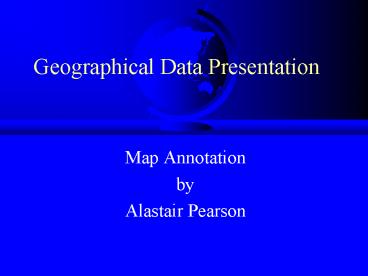Map Annotation - PowerPoint PPT Presentation
1 / 24
Title:
Map Annotation
Description:
Ascender line. Capital line. Mean line. Base line. Descender line. Counter ... proportions controlled by:descender line; mean line; ascender line; capital line ... – PowerPoint PPT presentation
Number of Views:32
Avg rating:3.0/5.0
Title: Map Annotation
1
Geographical Data Presentation
- Map Annotation
- by
- Alastair Pearson
2
Type Faces and Cartographic Design
- Robinson (1950) writes
- No matter how well designed a map might be
in other respects, it fails if the lettering it
depends upon for the transmission of its
information is treated improperly.
3
Introduction
- part of overall design process
- names figures
- reinforces classification hierarchy of features
- type face important in overall effect on map
legibility
4
Guidelines
- Few available
- little attention in most texts
- text familiar in newspapers and books - perhaps
contempt - Withycombe (1929) proposed principles
- good harmony of style
- legibility
- selection of suitable font for reproduction
5
General principles
- I) The importance can be expressed by the size
- II) The nature of the feature can be reflected in
the style e.g Ye Olde Oak Tree - III) Location is provided by placement
- IV) Extent is suggested by s p a c i n g
6
Characteristics of type
- Letter forms
- Roman alphabet - 2 distinct forms
- CAPITAL (UPPER-CASE)
- lower-case
7
D a g d
Characteristics of typographic
letter forms
Ascender line
Capital line
Mean line
Base line
Counter
Descender line
Loop
Bowl
8
Letter forms (cont.)
- Shapes proportions controlled bydescender
line mean line ascender line capital line - letters arranged on base line
- Shapes of bowls, loops and counters are slightly
different in different styles
9
- Orientation
- upright letter forms - Roman
- slanting letter forms - Italic
- Classification of type styles
- how letters are formed and terminated and their
relative proportions - three main types
10
- Serif
- small extensions that terminate strokes
- always vary in thickness and proportions of
strokes - Sans-serif
- No extended terminations
- little or no variation in stroke thickness
- Slab serif
- even stroke thickness of serif face
11
Type Size
- Typographic point measurement
- 72point 1inch
- refers to size of metal piece for printing
- 72 point text is smaller than 1 inch
12
Some suggestions
- Typeface selection
- Use a clear/clean typeface e.g. Helvetica or
Ariel - Sans-serif fonts print cleaner than serifed fonts
- Sans-serif fonts can be printed at a smaller size
and remain legible
13
- Type size
- vary size according to feature importance
- form a classification of type size based on
sensible criteria - only use 3 or 4 classes at most (depends on
amount of text)
14
Classifying text purpose
- Designative text
- Narrative Place Names
- Descriptive e.g. scenic route or ruined
- Functional e.g. Mountain Rescue Post
- Regulatory Legal, admin. or political
15
N E W P O R T P A R I S H
(Regulatory)
16
- Analytical
- Confirmative Confirms symbol meaning
- Determinative Provides absolute meaning
- Reference e.g. ED no.s on census map
- Categorisation e.g. Geological rock types
17
Name Placement
- complex and sophisticated process
- generally subjective
- conflicting objectives
- few attempts to write rules (Imhof, 1975 is best
known)
18
Imhofs basic rules
- names on maps should be
- legible
- easily associated with their relevant features
- must not overlap other map contents
- placed to show extent of the feature
- reflect the hierarchy of the features
- not densely clustered nor evenly dispersed
19
Point location names
- square to map border
- base line of letters no lower than centre of
point
Stourbridge
Stourbridge
Stourbridge
Stourbridge
Stourbridge
Stourbridge
Stourbridge
20
Linear features
- Rivers/roads etc
- alongside line
- avoid vertical or irregular stretches
- repeat if required
- better to have base line of names above feature
21
Danube
Danube
Danube
22
Complex name placement
23
Practical Guidelines
- Avoid writing Map showing..
- Avoid writing Key or Legend
- Avoid using CAPITALS
- Classify names by size (not too many classes)
24
(No Transcript)































